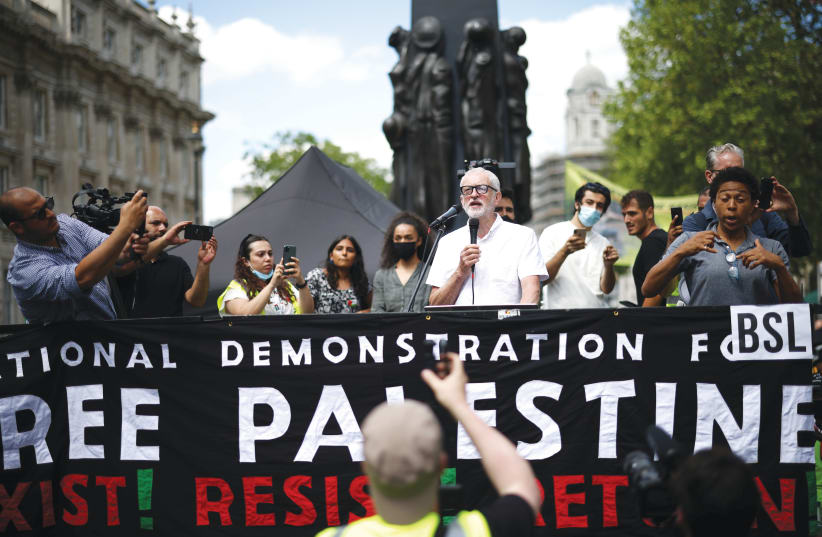On January 27, 2018, the anniversary of the liberation of the Auschwitz-Birkenau concentration camp, the Polish legislature made it illegal to mention the role of Poles in the murder of Jews during World War II. Two months later, during a tour promoting The Book of Exodus, photographer and writer Mikolaj Grynberg’s essay collection, a member of the audience interrupted the moderator’s comment that she was no longer embarrassed to identify him as a Jew.
“Let’s be honest with one another, you’re not a Pole,” the man said. “I am, but you’re not, and we both know that perfectly well, don’t we?” When Grynberg asked audience members if they agreed, all of them stared at their shoes; some muttered it was okay. The moderator remained silent.
In Looking For An Enemy, eight Jewish writers remind us that, as journalist and editor Jo Glanville puts it, antisemitic narratives began as a conflict between a “new sect that recognized Jesus as the Messiah and the Jews who rejected him,” and became embedded in Western culture following the circulation of ritual murder conspiracies. And they have “survived as a formula to be applied in any era.”
Understanding the resurggence of antisemitism in Europe and the US in the 21st century
The writers document – and reflect on – the 21st-century resurgence of antisemitism in Europe and the US. In France (which, after the revolution of 1789, granted equal rights to every male citizen, without regard to race, ethnicity, or religion), Natasha Lehrer, a translator and editor at the Jewish Quarterly, reveals that antisemitic acts rose by 74% in 2018. More than half the racist attacks targeted Jews, who comprise less than 1% of the total population.
Amid debates over “competitive victimhood,” pitting the Holocaust against the legacy of slavery, colonialism, and the war in Algeria, Lehrer points out, some activists in minority communities maintain that Jews have received official recognition because of their economic and political clout.
In the UK, according to Daniel Trilling, the author of Bloody Nasty People, explicit expressions of antisemitism are two to four times higher on the far right than in the general population. Philip Spencer, professor emeritus of Holocaust and Genocide Studies at Kingston University, agrees that even when politicians on the Left, including Jeremy Corbyn, former leader of the Labour Party, are staunch anti-racists and explicitly reject antisemitism, they often adopt patterns of thinking that underpin it.
German citizens, novelist Olga Grjasnowa claims, like to pretend that antisemitism ceased to exist in 1945. But, despite a critical examination of and formal apologies for Nazi atrocities by the government, a large percentage of them believe Jews talk too much about the Holocaust, have too much power over the economy, and are more loyal to Israel than to Germany. After quoting from the self-evidently antisemitic cabaret act of Austrian comedian Lisa Eckhart, Grjasnowa describes how arbiters of culture and the German branch of PEN “leapt to her defense.”
IN THE US, Rabbi Jill Jacobs, the executive director of T’ruah, a human rights organization, explains that Donald Trump has kept his antisemitism relatively subtle but easily understood by his base. In his 2016 presidential campaign, he tweeted an image of Hillary Clinton, surrounded by cash, in front of a Jewish star, with a caption stating, “Most corrupt candidate ever.”
Trump subsequently insisted that he thought the six-cornered figure was a “sheriff’s star.” And billionaire George Soros, a major contributor to progressive candidates and causes, continued to be one of his antisemitic dog whistles. Trump has reinforced the stereotype of Jews as “others,” Jacobs indicates, by legitimizing the “Jews shall not replace us” mantra of white supremacists and equating American Jews with Israel in a way that assumes they can never be good citizens of the country in which they live.
Not surprisingly, the contributors in Looking For An Enemy do not always agree. Differences are especially apparent on the question of when – and whether – anti-Zionism and criticism of the Israeli government constitute antisemitism.
Spencer castigates some on the Left in the UK for condemning Israel as “the worst state in the world,” guilty of “apartheid, crimes against humanity, even genocide,” and British Jews for moaning about “an antisemitism that no longer exists.” The Left’s new form of antisemitism, Spencer writes, “comes wrapped in the mantle of a reductionist anti-racism.”
Acknowledging that antisemitism remains a clear and present danger, and that calling for the expulsion of all Jews from Israel “clearly crosses the line,” Jacobs writes that calling attention to the “bloody origins” of the Jewish state does not. She maintains as well that although the Boycott, Divestment, Sanctions movement may stimulate traumatic memories of Nazi boycotts of Jewish businesses, “boycotting a country is not the same as boycotting a religious or ethnic group.”
And Israeli journalist and historian Tom Segev – the author, among other books, of One Palestine, Complete, and harsh critic of the occupation of the West Bank and Gaza – suggests that prime minister Netanyahu “greatly inflated” the danger of BDS and organized a “grandiose counter-offensive.” Although some racists camouflage their antisemitism as criticism of Israel, which they judge more harshly for human rights violations than any other country, Segev believes that negative attitudes toward the Jewish state or Zionism “should not be branded automatically” as antisemitism.
Editor Jo Glanville gives the last word in Looking For An Enemy to David Nirenberg, director and professor of the Institute for Advanced Study at Princeton University and author of the now iconic book Anti-Judaism. Nirenberg makes the consciously provocative suggestion that understanding the largest threats facing the world in terms of Israel is not all that dissimilar to the assessment of Europeans in the 1930s – that because Jews posed a danger to themselves and the common good, they could and should “be complicit in the removal of that danger.”
“The question has to be,” Nirenberg tells Glanville, “how do the Jews, or Israel, become a convincing explanation of what is wrong with the world?” A question that is especially difficult to answer because the “reality” that is posited has “already been shaped by how we’ve learned to think.”
The writer is the Thomas and Dorothy Litwin Professor of American Studies at Cornell University.
Looking For An EnemyEdited by Jo Glanville W.W. Norton & Company 158 pages; $25.95

